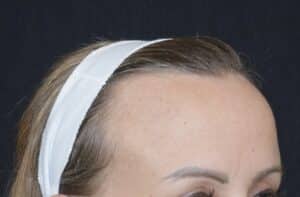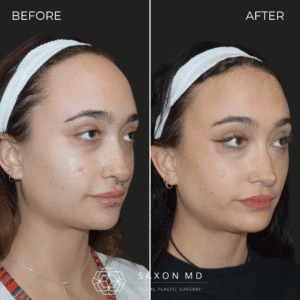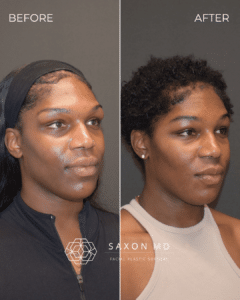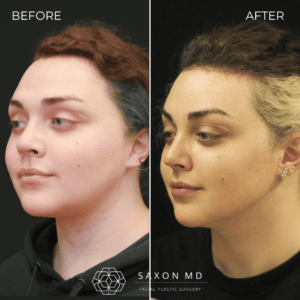Big Forehead Solutions
A big forehead is a common aesthetic concern that can affect both men and women. For many, it’s something they’ve lived with since childhood—whether due to a high hairline, prominent forehead bone structure, or a combination of both. Others may notice their forehead growing longer or wider with age, hair thinning, or hormonal changes.
If you feel like your forehead dominates your facial features, you’re not without options. At Saxon MD, Dr. Sarah Saxon is one of the few facial plastic surgeons who specializes in forehead sculpting and rejuvenation, offering both surgical and non-surgical treatments to reshape and refine the forehead area for a more balanced and harmonious look.
In this blog, we’ll break down what actually makes a forehead appear “big,” how it develops, and what you can do to reduce its appearance—whether you’re ready for surgery or just looking to explore your options.
What Makes a Forehead Look Big?
The size of your forehead is determined by multiple anatomical components, not just the distance from your eyebrows to your hairline. Let’s look at the main contributors:
1. Hairline Position
This is the most obvious factor. A high hairline makes the forehead appear longer vertically. While genetics is the primary reason for a high hairline, hair thinning or traction from tight hairstyles can also lead to a receding or elevated hairline over time.
2. Frontal Bone Prominence
The frontal bone—the bony part of the forehead just above the brows—can protrude more in some individuals, contributing to a sloped or overly convex appearance. In women especially, a prominent brow bone can look masculine or exaggerated.
3. Forehead Width
Many people only think about forehead height, but width plays a big role too. A wide forehead can result from the lateral extension of the frontal bone or from bulkiness of the temporalis muscle, which lies on either side of the head. Some people naturally have more muscle mass in this region, especially if they grind their teeth or clench their jaw.

How Does the Forehead Develop?
The shape and size of your forehead are largely determined in childhood and adolescence. The frontal bone fuses by the age of 8, and its size and prominence are genetically encoded. However, hormonal changes during puberty can also impact bone and soft tissue development.
In addition, testosterone exposure—whether naturally occurring or introduced—can cause the brow bone to become more prominent, which is why masculine foreheads often have a more pronounced ridge. Conversely, estrogen tends to soften bone structure, leading to a flatter, smoother forehead contour.
A high hairline can be present from birth or may result from gradual changes such as:
-
Traction alopecia from tight hairstyles (e.g., ponytails, braids)
-
Female pattern hair loss
-
Hormonal fluctuations (like during perimenopause or post-partum)
-
Post-surgical scarring or burns
-
Ethnic variation (certain groups naturally have higher or broader hairlines)
Easy Ways to Camouflage a Big Forehead
Not everyone is ready to pursue surgery, and that’s okay. There are some simple tricks to minimize the appearance of a big forehead without going under the knife:
-
Hairstyling: Wearing bangs or side-swept layers can instantly create the illusion of a smaller forehead.
-
Root powders or hairline concealers: These products darken the hairline area, which can visually lower the hairline and reduce contrast with the forehead skin.
-
Makeup contouring: Using a slightly darker powder along the hairline and temple area can soften the transition between the face and forehead.
-
Neuromodulator injections (like Botox or Jeuveau): For patients with wide foreheads due to temporalis muscle bulk, strategic injections can slim this area over time by shrinking the muscle, similar to how Botox is used for jawline slimming.

These options won’t change your anatomy, but they can be helpful in the short term or as a trial before committing to permanent changes.
Surgical Options to Treat a Big Forehead
For those looking for a more permanent and dramatic transformation, there are two main surgical options to reduce the appearance of a big forehead:
1. Hairline Lowering Surgery (Forehead Reduction Surgery)
This procedure physically moves the hairline forward by 2 to 3 centimeters (sometimes more, depending on scalp laxity). A wavy, irregular incision is made along the existing hairline so that the scar blends in naturally with the hair regrowth. The skin is lifted and repositioned, and any excess forehead skin is removed.
Why I Prefer Hairline Lowering Over Hair Grafts:
While hair grafting can be a great tool for refining the shape of the hairline or filling in small patches, it’s not ideal for creating a dramatic change in forehead height. Hair grafts:
-
Can’t provide the same density as natural hair
-
Often lack the correct angle or texture
-
Take months to grow in fully, and multiple sessions may be needed
Hairline lowering surgery, on the other hand, provides instant results with a natural hairline density—something that’s nearly impossible to achieve with grafts alone.
I often use hair grafting later on as a fine-tuning step, particularly if someone wants to round out the corners of the hairline or add softness to the temples.

2. Brow Bone Reduction (Frontal Bossing Reduction)
If the upper forehead looks prominent because of frontal bossing (a strong, protruding brow bone), brow bone reduction may be the best option. This procedure involves carefully reshaping the frontal sinus region of the skull, usually through an incision hidden in the hairline.
In some cases, the bone is simply contoured (shaved down), but for more severe bossing, a set-back technique is used, where the outer bone is removed, reshaped, and replaced for a flatter appearance.
This is a more advanced craniofacial surgery, so it’s important to seek out a surgeon like Dr. Saxon, who has extensive experience in facial bone work and understands both the aesthetic and functional anatomy of the forehead.

Combining Procedures for Optimal Results
Many patients benefit from combining both hairline lowering and brow bone reduction, especially if they have both a high hairline and prominent forehead curvature. These surgeries can often be performed during the same session for a more comprehensive and harmonious outcome.
For patients with wide foreheads, Dr. Saxon also evaluates whether the bulk of the temporalis muscle or the width of the frontal bone contributes more to the appearance. In some cases, surgical temporal reduction or neuromodulator injections into the temporalis can help achieve a slimmer look.

Why Choose Dr. Saxon for Forehead Surgery?
Forehead surgery isn’t something most plastic surgeons specialize in. It requires an in-depth understanding of facial anatomy, bone structure, hair dynamics, and artistic balance.
Dr. Sarah Saxon is one of the few facial plastic surgeons in the country who focuses specifically on forehead sculpting and rejuvenation. She combines advanced craniofacial techniques with a deep understanding of beauty aesthetics to deliver natural, long-lasting results.
Her approach is tailored to each patient, considering:
-
Scalp elasticity
-
Hair texture and pattern
-
Brow position
-
Frontal bone shape
-
Gender and ethnic aesthetic ideals
At Saxon MD, our goal is not to erase your features—but to refine and harmonize them in a way that feels uniquely “you.”
Ready to Redefine Your Forehead?
If your big forehead has always been something you hide with hairstyles, hats, or makeup, it may be time to explore your options. Whether you’re just curious or ready to take the next step, we’d love to help you feel more confident in your appearance.
Schedule a consultation with Dr. Saxon to discuss the best surgical and non-surgical treatments for your unique goals. With the right approach, a big forehead doesn’t have to be your defining feature.
You May Also Like:
- Brow Bone Reduction for Women With Frontal Bossing: Is It Worth It?
- How to Get a Smaller Forehead: Surgical and Nonsurgical Options Explained
- Brow Bone Reduction Cost: What You Need To Know
- Potential Brow Bone Reduction Complications
- Hairline Lowering vs Hair Grafts: Understanding Your Options for a Better Hairline
- Brow Bone Reduction Before and After Gallery
- Hairline Lowering Before and After Gallery